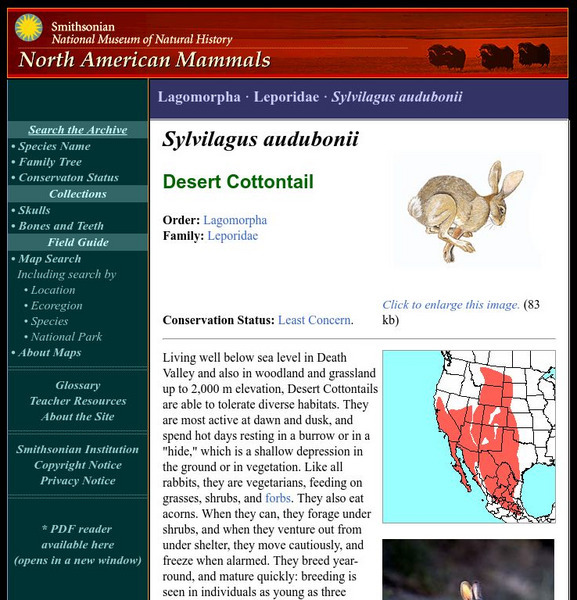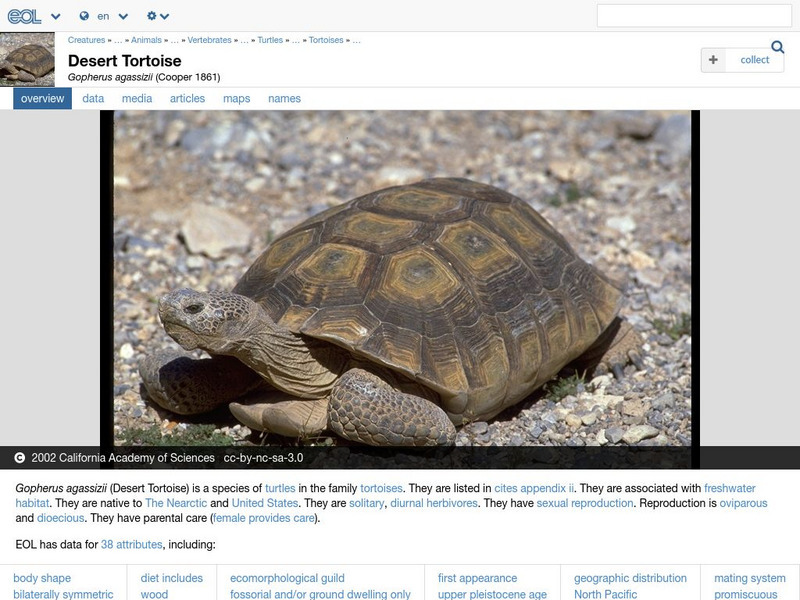Curated OER
Social Studies: Classroom Culture
Sixth graders compose a list of classroom cultural values. They begin with a list of unacceptable behaviors. Each student presents two ideas they think should be part of the class culture. Students try to persuade classmates to accept...
Curated OER
Critters & Complementary Colors
Students discover how specific colors compliment each other. Students use paints and pictures of animals to create a picture with analogous color harmony. They explain the characteristics of analogous colors.
Curated OER
Conservation and Environmental Protection
Students brainstorm a list of environments and animals from around the world that need protection. They then design and create a slogan about an animal or environment and an environmental protection poster.
Curated OER
Animal Life Histories Derived From Morphology
Students learn the mechanisms of natural selection by deducing information from the physical appearance of the animal.
BBC
Bbc Nature: Wildlife: Desert
Explore the fascinating world of the desert and discover what lives and grows there through videos, pictures, news, and external links. Listen to the various sounds happening in the desert.
Other
Desert Natural History/sonoran Desert
Discusses the habitats in the Sonoran Desert region and the subdivisions of the Sonoran Desert (Lower Colorado River Valley, Arizona Upland, Plains of the Sonora, Central Gulf Coast, Vizcaino, Magdalena, and foothills of Sonora)....
World Wildlife Fund for Nature
World Wildlife Fund: Our Earth: Ecoregions: Habitats: Deserts
An overview of the climate conditions of deserts. Includes examples of plants and the adaptations that allow them to survive in the dry climate. Includes a link to information about animals that live in a desert habitat.
TeachEngineering
Teach Engineering: Computer Simulation of the Sonoran Desert Community
The computer program's simulation of a Sonoran desert community should ultimately strengthen the student's comprehension of what is required for a natural ecosystem to sustain itself (remain in balance). This computer simulation program...
Other
National Wildlife Federation: Happenin' Habitats: What Is Habitat?
Find an overview of what a habitat is exactly. Then, for more information, click in the left hand menu for different types of habitat: forests, grasslands, deserts, wetlands, and arctic tundra. Authors also offer advice on creating a...
Enchanted Learning
Enchanted Learning: Biomes
Discover the hidden treasures in the different habitats on the earth! The earth is filled with many biomes. Examples of different biomes are listed and include hyperlinks to additional information such as the animals found there.
PBS
Pbs Learning Media: Teri and Jairus: Biome Buddies
This video segment from ZOOM compares and contrasts the habitat and life forms found in Death Valley with those found in the temperate rain forest of the Pacific Northwest. [3:46]
Smithsonian Institution
National Museum of Natural History: American Mammals: Desert Cottontail
Living well below sea level in Death Valley and also in woodland and grassland up to 2,000 m elevation, Desert Cottontails are able to tolerate diverse habitats. They are most active at dawn and dusk and spend hot days resting in a...
Encyclopedia of Life
Encyclopedia of Life: Desert Tortoise
The Encyclopedia of Life presents this in-depth overview of Desert Tortoises (Gopherus agassizii), including their habitats, size, conservation status, and much more. Images of this species and maps of its global distribution can also be...
PBS
Pbs Kids: Plum Landing: Can You Dig It?
Set in the Australian desert, players become bilbies to search at night for food while looking out for hungry predators like dingos, foxes, and swooping eagles.
PBS
Pbs Learning Media: Biomes
This interactive resource adapted from NASA describes the different temperature, precipitation, and vegetation patterns in seven biomes: coniferous forest, temperate deciduous forest, desert, grassland, rainforest, shrubland, and tundra.
Globio
Glossopedia: Environments
This article defines "environment" as a collection of animals and plants in a specific landscape and climate. The concept of differing types of environments is introduced. The impact of humans on environments and all environments'...
Utah Education Network
Uen: Utah's Plants and Animals Do You Know Where I Live?
Can you figure out what types of biomes different organisms belong in? You'll be presented with a variety of organisms and asked which of three biomes they belong in.
Houghton Mifflin Harcourt
Harcourt: School Publishers: Exploring Ecosystems
Compare and contrast three very different ecosystems - the Sonoran Desert in Arizona, the Florida Everglades, and the Arctic Coastal Plain in Alaska. Learn what makes each of them unique, and about the adaptations plants and animals had...
Geographypods
Geographypods: Introduction to Ecosystems and Biomes
Using worksheets, images, videos, and internet resources, students will be able to learn the names and locations of the seven major global biomes in the correct order from polar regions to the equator.
Smithsonian Institution
National Museum of Natural History: American Mammals: San Diego Pocket Mouse
The San Diego Pocket Mouse occurs in desert and coastal habitats in southern California, Mexico, and northern Baja California, from sea level to at least 1,400 m. Yellowish or orange hair on its sides contrasts with a dark brown back,...
Smithsonian Institution
National Museum of Natural History: American Mammals: Southwestern Myotis
Southwestern myotis live in a variety of southwestern mountain habitats, from desert grasslands up into pine and mixed coniferous forest in the United States, and in desert and grassland in Mexico. These bats and two other myotis...
Smithsonian Institution
National Museum of Natural History: American Mammals: Mule Deer
Mule Deer live in a broad range of habitats - forests, deserts, and brushlands. Mountain populations migrate to higher elevation in warmer months, looking for nutrient-rich new-grown grasses, twigs, and shrubs. Learn more about the...
Smithsonian Institution
National Museum of Natural History: American Mammals: Western Pipistrelle
Western pipistrelles sometimes leave their roosts before sundown and can be mistaken for late-flying butterflies, because they are so tiny and fly slowly and erratically, with much fluttering of their wings. Most common at low elevations...
Smithsonian Institution
National Museum of Natural History: American Mammals: Least Chipmunk
The least chipmunk is the smallest and most widely distributed North American chipmunk. It occurs in a variety of habitats, from coniferous forests to meadows to sagebrush desert, feeding primarily on seeds but also eating flowers, buds,...






















